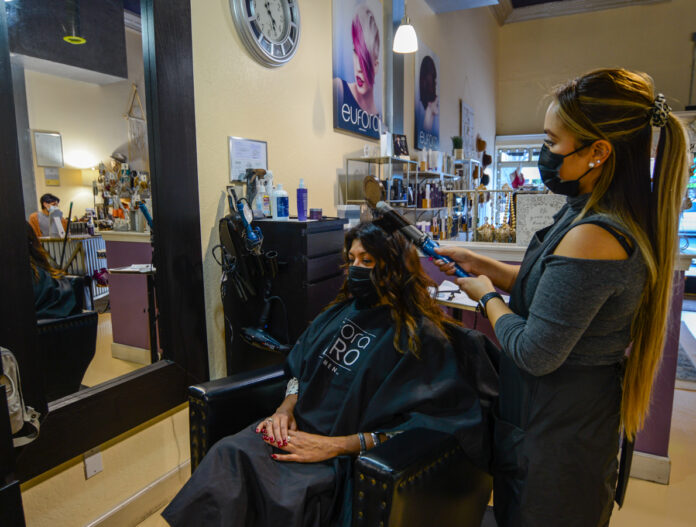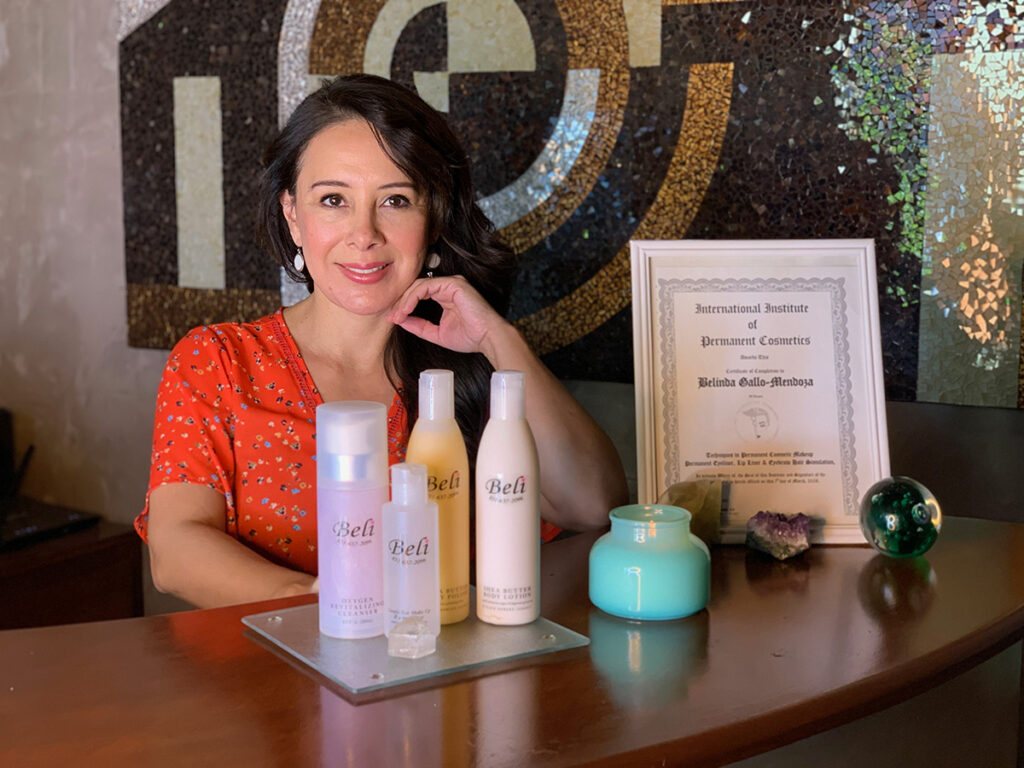
It’s been a roller coaster year for Bella Mia Salon owner and stylist Olga Arreola, who last week was able to reopen her shop for the first time since December.
The guidelines are just the same as the first two times: one guest per stylist and they are limited to how many people they can take in. The shop, located at 729 San Benito St., is big enough where the stylists can be spread out and Arreola knows safety is the number one priority.
Arreola understands the restrictions because it’s part of the state guidelines set by the California Department of Public Health. Still, the stylists are making less money than what they’re accustomed to and they work more hours for less pay.
“We’re happy to be back to work, but we’re also under guidelines and we can’t fully work like we used to before,” she said.
Arreola, 47, was able to retain her staff of nine stylists but it wasn’t that long ago that they had to wait a while just to get their unemployment benefits. She mentioned it was tough for her to charge them rent, including those who are contracted as independent renters.
She used her savings from the salon to cover the costs. After two months she realized she could no longer use those funds and asked her staff to pay at least half of their rent fee so she could keep the business alive.
“It was hard financially for myself as an owner and for my staff, too,” she said. “I know we’re not considered essential, apparently to our governor, but I think we are essential.”
Heaven Scent Day Spa & Salon owner Belinda Gallo said it’s nice to finally get back to work because the loan and grant funds can only go so far. Plus, the money doesn’t last long when the cost of rent is pricey.
She has mixed feelings about being forced to close the doors to her shop. When the pandemic first started, Gallo didn’t know anyone who had the virus except for those she heard about in the news.
“As time progressed, I think pretty much everybody knows someone that has it or had it,” she said.
Gallo, 48, admits that there’s still fear of contracting Covid-19, however, she still needs to work in order to make money. She doesn’t have to manage a large staff, which means there’s no need to worry about shifting around other stylists schedules.
Arreola said the first shutdown in March was the worst because she never felt what it was like wanting to work but not being able to do so after being in business for the past 17 years.
“I had never been in a situation where no income was coming in,” she said. “That was a very tough time for me as an owner for the salon.”
She mentioned the business had some savings set aside but what was really hard for her was not knowing when they were going to reopen. There was a business plan set in place, however, there were no guidelines in case of a virus outbreak such as the coronavirus.
And Arreola still had to pay a lease and bills for both her business and home as well.
Her income was completely cut off for several months and she began to realize how much of a financial responsibility she has under her name.
“It was kind of an eye opener,” she said. “It made me look at my business more and see where maybe some ways I could be saving and maybe I was spending a little too much. It made me cautious of everything.”
The first shutdown lasted a little more than two months and they were able to reopen in June. Luckily she knew what to expect for the second time around and it wasn’t as emotionally tough on her.
The Regional Stay-at-Home order in December forced Arreola to close Bella Mia Salon’s doors for a third time and Arreola knew she needed to do something extra.
“My right to work had never been taken away, this is my profession. I never saw that coming,” she said.
She invested both time and money to open an online store, Ella Boutique, to provide her some type of income. She’s never had to advertise for her shop but without her clients and no foot traffic there was nobody around to purchase items in person.
“This is something new for me and I learned a lot,” she said. “But I had to find a way to make income somehow.”

Gallo was able to update her website and she also spent time on a side project she calls “Beli,” which is a new skin care line that’s in the works. She’s been in the business for 17 years and she was confident that her group of loyal clientele would return to her shop, located at 601 San Benito St., once she reopened.
Still, there was the rent and bills to worry about including PG&E service, which Gallo had to pay even if the business was prohibited from operating. She mentioned that the landlord has allowed her to fall behind on her lease but that can only go so far, as well.
“It’s going to be tough having to pay back loans plus my rent but I invested so much in the business,” she said. “I put so much money into it, I am not going anywhere.”
Personal care industry shunned by state officials
San Benito County officials said that they have no knowledge of any coronavirus outbreaks traced back to salons.
In a lawsuit filed Jan. 21 against Gov. Gavin Newsom and other state officials, the Professional Beauty Federation of California (PBFC) argues California singled out the industry because of its lack of lobbying power.
“The personal services sectors are the quintessential small business sectors,” PBFC attorney Fred Jones says in a phone call, “and yet, because we don’t have the same clout as Hollywood or big business, we have become the sacrificial lambs to the Covid gods.”
It’s a sacrifice borne disproportionately by minorities, he points out.
The state’s assiduous focus on salons and cosmetic services has hammered an industry composed overwhelmingly of women, immigrants and members of LGBTQ community. Of PBFC’s 621,000 dues-paying licensees, Jones says, more than 80 percent are female and 75 percent are first-generation immigrants.
“This is the profession that this governor has sacrificed,” he says. “That’s not very politically correct, is it?”
That doesn’t bode well for the state’s economic recovery. A recent report by accounting software firm Freshbooks found that woman-owned businesses take nearly three times longer to recover from the pandemic’s financial setbacks than those owned by men. The same holds true for other minority-owned businesses.
In Jones’ telling, the beauty industry’s financial woes began when Gov. Newsom blamed a Northern California nail salon for the first known case of community spread of the novel coronavirus. PBFC, reporters and other industry groups demanded data to support the assertion. State officials never provided that.
Newsom’s claim proved baseless. But the damage was done.
“What he didn’t realize was that he was throwing all this shade at our industry in the minds of Californians,” Jones says. “As a result, we’ve had a cumulative seven months of lockdowns. This is our third reopening after our third closure since March, and every time we reopen, there are less clients coming back because they’re picking up the message that this industry is unsafe.”
While state officials and their local counterparts repeated the narrative of the dangers inherent to salons, research by the U.S. Centers for Disease Control and Prevention (CDC) suggested otherwise. The study published last summer found face masks may have prevented a pair of Covid-positive Missouri hairstylists from spreading the virus to as many as 140 clients.
Missouri’s Springfield-Greene County Health Department, which led the investigation, determined that policies requiring people to cover mouths and noses and the salon’s strict sanitation policies played a substantial role in curbing what could have been a huge outbreak.
Jen Erickson, founder and CEO of Silicon Valley Apprenticeship Barbering/Cosmetology and a 25-year industry veteran, said clients should rest assured that salons are safe to patronize. Passing the California Board of Barbering and Cosmetology test requires 1,600 class-hours—about 1,000 more than needed to become a police officer—and fluency in sterilization and cross-contamination.
“With the pandemic,” she said, “a lot of us even went above and beyond, retrofitting salons to make things safe, spending money even though we weren’t making any.”
If public health officials produced data that showed salons as high-risk for coronavirus outbreaks, that would be one thing, Jones said. But he has yet to see any from the state or local governments. What few numbers are available seem to back his suspicions about the shutdowns being less science-and-data-based than Newsom lets on.
Statistics released in December by the New York Gov. Andrew Cuomo’s office show that 74 percent of Covid cases for which there’s contact-tracing data available were attributed to household gatherings. Bars and restaurants accounted for just 1.43 percent of the spread. Salons and personal care services, just 0.14 percent.
Jones wants to see similar California data.
Arreola knows that the virus is real and people are still falling ill from it but she doesn’t believe it was necessary to shut down the salons. She mentioned that it’s not like a grocery store where large groups of people can step inside.
“If it was so bad like they said it was in the county, why was retail open?” she said. “Everything should’ve been shut down.”
She said that keeping a clean and sanitized working area is part of obtaining a license.
“We have to look out for the consumer but now with this new guidance of taking the temperature, hand sanitizing everybody before they come and doing it for ourselves, it’s just being mindful and we wipe after each person.”
Arreola said the hardest part dealing with the pandemic is not knowing when they’ll be able to reopen, which in return has caused a lot of anxiety. She’s had second thoughts about the salon, questioning if it was time to give up as a business owner or if this was the right career choice.
If the county starts going backwards and the state orders another regional stay-at-home order, Arreola fears that she won’t be able to bounce back unless she gets a grant and another loan.
“I’ve learned to save and I have saved,” she said. “If I have enough of that it would help but at this moment right now I can’t even recuperate from the last shutdown.”
Editors note: San Jose Inside reporter Jennifer Wadsworth contributed to this article.









